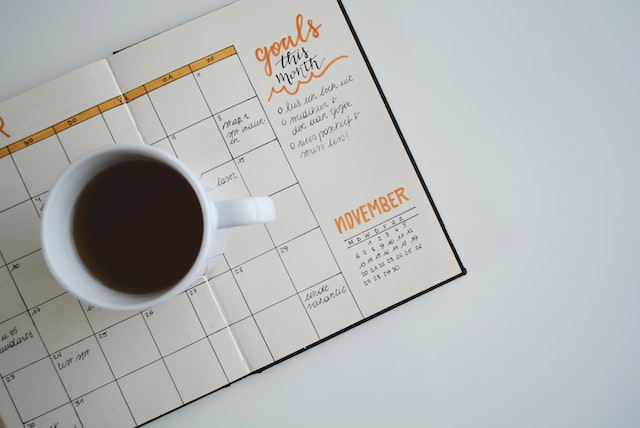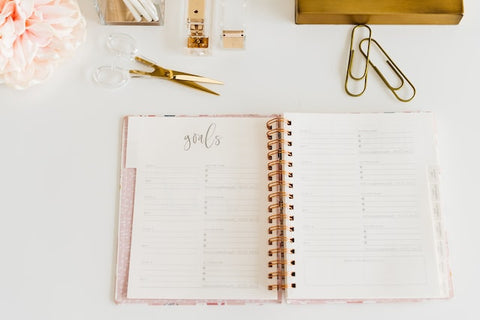
How to break down your goals into monthly/weekly/daily tasks
Whenever the new year rolls around, it's time for us to start dreaming big. With a new year comes a fresh start, and an endless amount of possibilities to achieve.
But for a lot of us, those dreams and goals can become overwhelming (or forgotten about). As we settle into January and the summer starts coming to an end, our lives resume their busy, hectic nature. We don't know where to start, or how to break down our goals into manageable tasks, so our goals or New Year's resolutions are left in the dust.
But it doesn't need to be that way. That's where planners come in!
Anyone who wishes to achieve their goals should use planners as a necessary tool. By breaking down your long-term goals into monthly, weekly or daily tasks, the overarching goal becomes a whole lot more attainable.
At the Calendar Club, we know how hard it can be to get your goals in order. And because it's difficult, people have often put off the idea of pursuing their dreams, hesitant and scared. That's why we're here to help you make your life easier – and a whole lot more organised. We know how to do a New Years goal setting planner, and we're going to tell you how to as well.
Step 1: Work out what your yearly goal is
The first step is always the hardest, but it's important to take the time to figure out what you want to achieve in the span of one year. Although a year is a long period of time, it flies by (if you haven't heard that enough already).
Your goal doesn't have to be big and scary. Although these are great if you're planning on changing careers, starting your own business or something else exciting, you can set much simpler goals. This could be anything from reading a certain number of books, taking a trip somewhere new, learning a new skill or going to the gym.

If you need space to brainstorm goal ideas, all planners we stock have extra pages wherein you can jot down notes to your heart’s content!
Some popular yearly goals to draw inspiration from include:
- Changing careers
- Turning a passion into a business
- Learning a new language
- Establishing a regular gym routine
- Developing a healthy sleep schedule
- Meditating or practising mindfulness
It's a great idea to set aside some time to think about what you would like your New Years goals to be. It could be as little as 15 minutes, but when goal setting you need to think carefully about what's realistic and achievable. Writing lists helps your brain declutter, so it's a great option to jot your goals down.
With your goals fresh in your mind, here's how to do a new years goal setting planner.
Your monthly to-dos
Rome wasn't built in a day, and the odds of you achieving your yearly goal in 24 hours isn't very likely, either. Goals need to be broken down into manageable tasks that can be completed each month. This way, there's a far less likely chance of getting burnt out, overloading yourself or becoming too overwhelmed.
Your monthly to-dos should reflect the yearly goal you've set for yourself. So, if you're looking to establish a regular gym routine, your monthly task could be going to the gym multiple times a week. It's best not to rush right into your new routine, otherwise you will burn yourself out, so starting off with 2-3 days a week is a great entry-point.
Monthly planners help you to stay on top of your monthly goals while weekly tasks fill your mind. Calendar Club's monthly planners come in all sorts of colours and sizes to suit a range of aesthetics.
Your weekly to-dos
Your weekly to-dos don't just have to be goal related. Writing down your appointments and responsibilities in your weekly planner will allow you to assess where you have time to slot in your goals throughout the week.
Your weekly to-dos should be specific tasks that help you complete your monthly goal. So, if your monthly goal is going to the gym multiple times a week, your weekly tasks might look something like this:
- Monday: Gym at 6pm
- Tuesday: Rest day
- Wednesday: Pilates at 8pm
- Thursday: Rest day
- Friday: Gym at 10am
- Saturday: Rest
- Sunday: Family walk 1:30pm
These weekly tasks become your non-negotiable appointments that you make with yourself. By having these in your planner, you're more likely to stick to them and achieve your monthly goals.
Your daily to-dos and tracking daily progress
Now you're set for the month and week, let's move onto how to write a daily planner. Your daily to-dos are the things that need to happen in order for you to complete your weekly tasks. They might be as simple as packing your gym bag the night before or laying out your clothes for tomorrow's pilates class.
Your daily to-dos should help make your weekly tasks easier. So, if one of your weekly tasks is going to the gym on Monday at 6pm, your daily tasks will help you stay on track for that goal by making your days more organised.
It feels great to physically tick something off a list, so once the task is done, cross that baby out! This process also helps you track your daily progress, ensuring you achieve everything you need to throughout your day.
How using a planner can help you track progress and plan goals
A planner is a great way to help you track progress and plan goals. By breaking down your goals into monthly, weekly or daily tasks, you can better assess what needs to be done in order to achieve your overarching goal. This process also helps to make your goals more manageable and less daunting, because goals can be scary!

The Calendar Club is here to support you through your goal-setting journey, no matter how new or far along you are to the process! Read prioritisation tips when it comes to goal setting, how to stay on top of a busy schedule or shop our planners to get a kickstart on your new years goals.